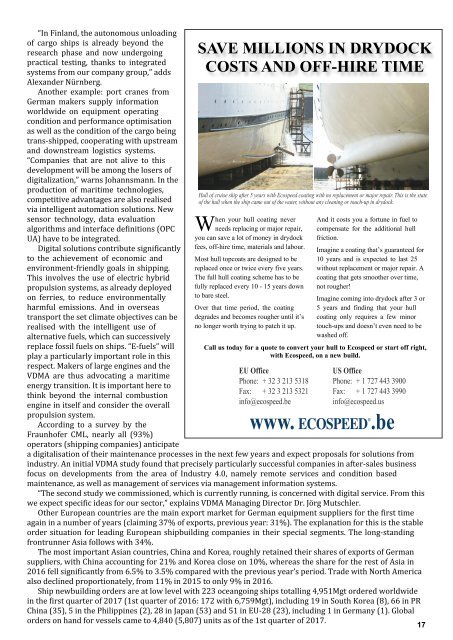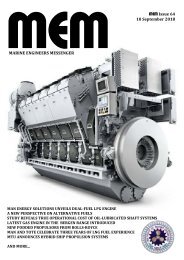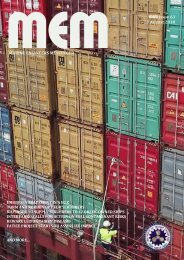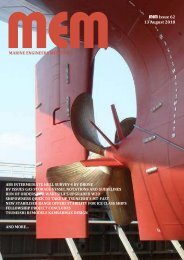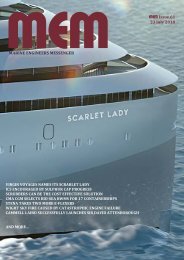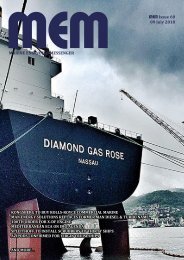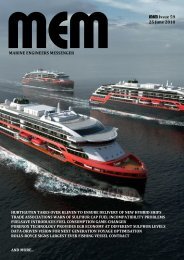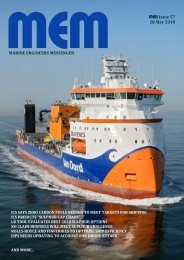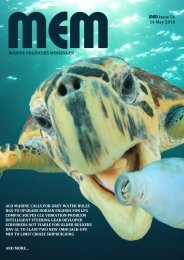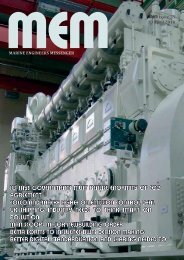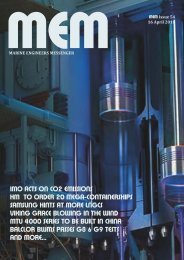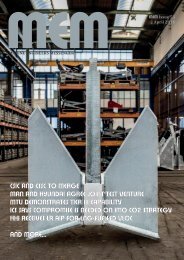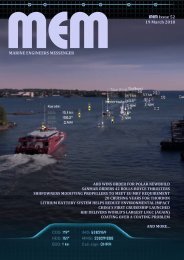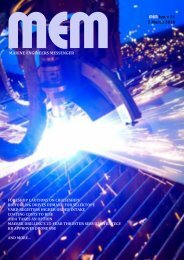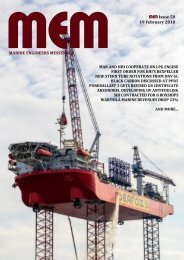Create successful ePaper yourself
Turn your PDF publications into a flip-book with our unique Google optimized e-Paper software.
“In Finland, the autonomous unloading<br />
of cargo ships is already beyond the<br />
research phase and now undergoing<br />
practical testing, thanks to integrated<br />
systems from our company group,” adds<br />
Alexander Nürnberg.<br />
Another example: port cranes from<br />
German makers supply information<br />
worldwide on equipment operating<br />
condition and performance optimisation<br />
as well as the condition of the cargo being<br />
trans-shipped, cooperating with upstream<br />
and downstream logistics systems.<br />
“Companies that are not alive to this<br />
development will be among the losers of<br />
digitalization,” warns Johannsmann. In the<br />
production of maritime technologies,<br />
competitive advantages are also realised<br />
via intelligent automation solutions. New<br />
sensor technology, data evaluation<br />
algorithms and interface definitions (OPC<br />
UA) have to be integrated.<br />
Digital solutions contribute significantly<br />
to the achievement of economic and<br />
environment-friendly goals in shipping.<br />
This involves the use of electric hybrid<br />
propulsion systems, as already deployed<br />
on ferries, to reduce environmentally<br />
harmful emissions. And in overseas<br />
transport the set climate objectives can be<br />
realised with the intelligent use of<br />
alternative fuels, which can successively<br />
replace fossil fuels on ships. “E-fuels” will<br />
play a particularly important role in this<br />
respect. Makers of large engines and the<br />
VDMA are thus advocating a maritime<br />
energy transition. It is important here to<br />
think beyond the internal combustion<br />
engine in itself and consider the overall<br />
propulsion system.<br />
According to a survey by the<br />
Fraunhofer CML, nearly all (93%)<br />
operators (shipping companies) anticipate<br />
SAVE MILLIONS IN DRYDOCK<br />
COSTS AND OFF-HIRE TIME<br />
Hull of cruise ship after 5 years with Ecospeed coating with no replacement or major repair. This is the state<br />
of the hull when the ship came out of the water, without any cleaning or touch-up in drydock.<br />
When your hull coating never<br />
needs replacing or major repair,<br />
you can save a lot of money in drydock<br />
fees, off-hire time, materials and labour.<br />
Most hull topcoats are designed to be<br />
replaced once or twice every five years.<br />
The full hull coating scheme has to be<br />
fully replaced every 10 - 15 years down<br />
to bare steel.<br />
Over that time period, the coating<br />
degrades and becomes rougher until it’s<br />
no longer worth trying to patch it up.<br />
And it costs you a fortune in fuel to<br />
compensate for the additional hull<br />
friction.<br />
Imagine a coating that’s guaranteed for<br />
10 years and is expected to last 25<br />
without replacement or major repair. A<br />
coating that gets smoother over time,<br />
not rougher!<br />
Imagine coming into drydock after 3 or<br />
5 years and finding that your hull<br />
coating only requires a few minor<br />
touch-ups and doesn’t even need to be<br />
washed off.<br />
Call us today for a quote to convert your hull to Ecospeed or start off right,<br />
with Ecospeed, on a new build.<br />
EU Office<br />
Phone: + 32 3 213 5318<br />
Fax: + 32 3 213 5321<br />
info@ecospeed.be<br />
www.<br />
US Office<br />
Phone: + 1 727 443 3900<br />
Fax: + 1 727 443 3990<br />
info@ecospeed.us<br />
.be<br />
a digitalisation of their maintenance processes in the next few years and expect proposals for solutions from<br />
industry. An initial VDMA study found that precisely particularly successful companies in after-sales business<br />
focus on developments from the area of Industry 4.0, namely remote services and condition based<br />
maintenance, as well as management of services via management information systems.<br />
“The second study we commissioned, which is currently running, is concerned with digital service. From this<br />
we expect specific ideas for our sector,” explains VDMA Managing Director Dr. Jörg Mutschler.<br />
Other European countries are the main export market for German equipment suppliers for the first time<br />
again in a number of years (claiming 37% of exports, previous year: 31%). The explanation for this is the stable<br />
order situation for leading European shipbuilding companies in their special segments. The long-standing<br />
frontrunner Asia follows with 34%.<br />
The most important Asian countries, China and Korea, roughly retained their shares of exports of German<br />
suppliers, with China accounting for 21% and Korea close on 10%, whereas the share for the rest of Asia in<br />
2016 fell significantly from 6.5% to 3.5% compared with the previous year’s period. Trade with North America<br />
also declined proportionately, from 11% in 2015 to only 9% in 2016.<br />
Ship newbuilding orders are at low level with 223 oceangoing ships totalling 4,951Mgt ordered worldwide<br />
in the first quarter of 2017 (1st quarter of 2016: 172 with 6,759Mgt), including 19 in South Korea (8), 66 in PR<br />
China (35), 5 in the Philippines (2), 28 in Japan (53) and 51 in EU-28 (23), including 1 in Germany (1). Global<br />
orders on hand for vessels came to 4,840 (5,807) units as of the 1st quarter of 2017.<br />
17


